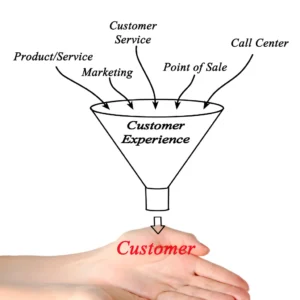
Revolutionizing Retail
Harnessing AI Tools for B2C Sales and Conversion Optimization
This article explains the landscape of Retail B2C Industry AI Tools for Sales and Conversion Optimization, exploring a comprehensive toolset designed to revolutionize the customer journey.
Integrating AI tools has become a cornerstone for businesses seeking to optimize sales and enhance conversion rates in the fast-paced retail realm, where customer expectations are ever-evolving.
From the immersive experiences of AI-powered Virtual Try-Ons to the efficiency of Chatbot-Assisted Checkout, the article navigates through the intricacies of Abandoned Cart Recovery, Automated Upselling and Cross-Selling, and the seamless integration of Voice Commerce.
This study discusses how AI is transforming the retail landscape by offering new and innovative solutions to engage customers and stay ahead in a highly competitive market. It explores the technical details, training requirements, challenges, and benefits of AI in retail.
Table of Contents
AI Tool ideas for Sales and Conversion Optimization
Building a Retail B2C Industry AI Toolset for Sales and Conversion Optimization requires careful consideration of each tool’s functionality and integration. Here’s a breakdown of the key features for each tool:
AI-Powered Virtual Try-Ons:
- Augmented Reality (AR) Integration: Provide a seamless AR experience for customers to try on products virtually.
- Product Catalogue Integration: Ensure a comprehensive catalogue of products with detailed information for virtual try-ons.
- User-Friendly Interface: Develop an intuitive, user-friendly interface for a smooth virtual try-on experience.
Chatbot-Assisted Checkout:
- Seamless Integration: Integrate the chatbot with the checkout system to guide users through purchasing.
- Natural Language Processing (NLP): Implement NLP capabilities for the chatbot to respond to customer queries effectively.
- Multiple Payment Gateways: Support various payment options for a convenient checkout process.
Abandoned Cart Recovery:
- Real-Time Monitoring: Monitor abandoned carts in real-time to identify and react promptly.
- Personalized Messaging: Send customized messages to customers with incentives to encourage them to complete their purchases.
- Integration with Communication Platforms: Integrate with email and messaging platforms for effective communication.
Automated Upselling and Cross-Selling:
- Recommendation Algorithms: Implement advanced algorithms to suggest complementary products based on customer browsing history.
- Real-Time Updating: Ensure that upsell and cross-sell suggestions are updated in real-time, reflecting changes in inventory or customer behaviour.
- Integration with Catalogue and Inventory: Seamlessly integrate with the product catalogue and inventory systems for accurate recommendations.
Voice Commerce Integration:
- Integration with Voice-Enabled Devices: Support integration with popular voice-enabled devices and platforms.
- Natural Language Understanding (NLU): Incorporate NLU to understand voice commands accurately.
- Secure Authentication: Implement authentication processes for voice-activated purchases to ensure customer data safety.
Combining these tools allows you to create a powerful AI-driven toolset for the Retail B2C Industry, enhancing sales and conversion optimization processes while providing customers with a personalized and innovative shopping experience.
Business Knowledge Requirements
Understanding Customer Behaviour:
A deep understanding of customer behaviour is crucial to developing AI tools for sales and conversion optimization in the retail B2C industry. Recognizing the decision-making process, preferred product categories and browsing patterns will help tailor the AI tools effectively.
Virtual Try-Ons:
The Business knowledge requirements for implementing AI-powered Virtual Try-Ons involve:
- Recognizing popular products within the industry.
- Understanding customer preferences for trying on products virtually.
- Staying informed about emerging trends.
A grasp of how customers interact with AR experiences and a keen awareness of the product catalogue is essential.
Chatbot-Assisted Checkout:
Understanding the nuances of the checkout process in a retail context is paramount. Knowledge of common customer queries, potential friction points during Checkout, and familiarity with various payment gateways is essential. Being attuned to customer language and preferences is critical for implementing Natural Language Processing (NLP) in chatbot interactions.
Abandoned Cart Recovery:
To recover abandoned carts effectively, one must comprehend the reasons behind cart abandonment, such as costs or unclear product information. Crafting personalized messaging requires an understanding of the target audience and the ability to provide enticing incentives that resonate with customers.
Automated Upselling and Cross-Selling:
In-depth knowledge of the product catalogue and inventory is vital for crafting algorithms that suggest relevant upsells and cross-sells. Understanding the customer’s journey and preferences aids in creating personalized recommendations, enhancing the chances of successful upselling.
Voice Commerce Integration:
Understanding the growing popularity of voice-enabled devices and platforms is essential for integrating voice commerce. Non-technical knowledge involves recognizing customers’ typical language for voice commands and ensuring secure authentication processes for voice-activated purchases.
Overall Business Context:
A comprehensive grasp of the retail B2C industry’s competitive landscape, market trends, and customer expectations is crucial. Knowledge of how these AI tools fit into the broader business strategy and contribute to enhancing the overall customer experience is essential for successful implementation.
Technical Knowledge Requirements
Virtual Try-Ons Technical Requirements:
Technical proficiency in Augmented Reality (AR) development is crucial to implementing AI-powered Virtual Try-Ons. Knowledge of AR frameworks such as ARKit (iOS) or ARCore (Android) is essential. Additionally, familiarity with 3D modelling tools and platforms like Unity or Unreal Engine is necessary to create virtual product representations. Developers should be adept at integrating these AR elements seamlessly into mobile or web applications, ensuring a smooth and realistic virtual try-on experience.
Chatbot-Assisted Checkout Technical Requirements:
For a Chatbot-Assisted Checkout system, expertise in Natural Language Processing (NLP) is fundamental. Programming languages like Python, which offers robust NLP libraries like NLTK and spaCy, are commonly employed. Integration with checkout systems requires knowledge of web development technologies such as JavaScript and frameworks like React or Angular. Developers must also be well-versed in API integration to seamlessly connect the chatbot with various payment gateways.
Abandoned Cart Recovery Technical Requirements:
Real-time monitoring of abandoned carts necessitates a backend system that tracks user activities. This involves knowledge of database management systems like MySQL or MongoDB. Implementing personalized messaging and incentives involves utilizing email and messaging APIs, requiring proficiency in tools like SendGrid or Twilio. Integration with email and messaging platforms, such as Gmail or SMS gateways, demands knowledge of relevant protocols and authentication mechanisms.
Automated Upselling and Cross-Selling Technical Requirements:
Algorithms for suggesting complementary products require expertise in machine learning and data analytics. Programming languages like Python and ML libraries like TensorFlow or PyTorch are used. Integration with product catalogue and inventory systems involves API communication and database querying. Real-time updating of suggestions requires a scalable and responsive backend infrastructure, possibly leveraging cloud services like AWS or Azure.
Voice Commerce Integration Technical Requirements:
Integrating with voice-enabled devices mandates knowledge of voice recognition technologies. Platforms like Amazon Alexa, Google Assistant, or Microsoft Azure Speech Services require specific API integrations. Natural Language Understanding (NLU) for interpreting voice commands involves using frameworks like Dialogflow or Wit.ai. Secure authentication for voice-activated purchases may require implementing biometric authentication or integrating with secure identity management systems.
Overall Technical Integration Requirements:
A holistic understanding of web and mobile application development is crucial for seamlessly integrating these tools. Full-stack development skills encompassing frontend (HTML, CSS, JavaScript) and backend (Node.js, Django, Flask) technologies are beneficial. Knowledge of cloud platforms, for instance, AWS, Azure, or Google Cloud, is essential for hosting and scaling these applications. Security protocols like HTTPS, data encryption, and secure API communication are imperative to safeguard customer information.
Technical Integrations Requirements
API Integrations for Virtual Try-Ons:
After developing AI-powered Virtual Try-Ons, seamless integration with the existing product catalogue and inventory systems is crucial. This involves creating APIs (Application Programming Interfaces) that enable real-time communication between the Virtual Try-On application and the product database. Integration points may include fetching product information, updating inventory status, and synchronizing data to ensure a consistent and up-to-date virtual try-on experience.
Chatbot-Checkout System Integration:
Upon building the Chatbot-Assisted Checkout system, integrating it with the e-commerce platform’s checkout system is essential. API integration is critical here, allowing the chatbot to interact with the checkout system, retrieve order details, and seamlessly guide users through the payment process. The integration must be secure and compatible with various payment gateways, requiring in-depth knowledge of payment processing APIs and protocols.
Abandoned Cart Recovery Communication Platforms:
Integration with communication platforms like email and messaging services is vital for Abandoned Cart Recovery. APIs from Twilio or SendGrid must be integrated to enable personalized messaging. This involves triggering automated messages based on abandoned cart events and utilizing API calls to external messaging services to re-engage customers effectively.
Automated Upselling and Cross-Selling with Catalogue and Inventory Systems:
After implementing algorithms for Automated Upselling and Cross-Selling, integration with the product catalogue and inventory systems is necessary. This integration ensures that upsell and cross-sell suggestions are dynamically updated based on real-time inventory data. APIs are employed to fetch product information, track inventory levels, and adjust recommendations accordingly, creating a seamless and accurate upselling experience.
Voice Commerce Integration with Voice-Enabled Devices:
Upon developing Voice Commerce Integration, interfacing with voice-enabled devices requires specific integrations. Platform APIs like Amazon Alexa Skills Kit, Google Assistant SDK, or Microsoft Azure Speech Services connect the application with the voice recognition and NLU systems. This integration ensures that voice commands are accurately processed and secure authentication protocols are followed for voice-activated purchases.
Overall Integration with Business Systems:
After building the individual tools, an overarching integration is needed with the existing business systems. This involves connecting the AI tools to the broader e-commerce infrastructure, ensuring data flow between the tools and core business databases. A comprehensive understanding of APIs, data formats, and secure communication protocols is essential for this integration, ensuring a cohesive and efficient operation of the entire Retail B2C Industry AI Toolset for Sales and Conversion Optimization.
Current AI Tools and Technologies available for Sales and Conversion Optimization
AR Development Platforms:
Several AR development platforms are readily available in the current market to facilitate the creation of AI-powered Virtual Try-Ons. Unity and Unreal Engine are versatile tools offering robust features for immersive AR experiences. These platforms provide developers with various functionalities, including 3D modelling, animation, and real-time rendering, enabling the seamless integration of virtual try-on capabilities.
NLP Libraries and Frameworks:
Natural Language Processing (NLP) libraries and frameworks are essential for Chatbot-Assisted Checkout. NLTK (Natural Language Toolkit) and spaCy in Python are widely used for processing and understanding human language. These libraries come with pre-trained models, making it easier for developers to implement NLP in chatbot interactions. Tools like Rasa or Dialogflow also provide comprehensive platforms for building chatbots with NLP capabilities, simplifying the development process.
Cloud Services for Real-Time Monitoring and Integration:
Abandoned Cart Recovery relies on real-time monitoring and integration with communication platforms. Cloud services like AWS (Amazon Web Services) or Azure provide scalable solutions for real-time data processing. AWS Lambda or Azure Functions can trigger actions based on abandoned cart events. For communication, tools like Twilio or SendGrid offer APIs for seamless integration with email and messaging platforms, enhancing the abandoned cart recovery process.
Machine Learning Libraries for Automated Upselling and Cross-Selling:
Implementing algorithms for Automated Upselling and Cross-Selling involves leveraging machine learning libraries. TensorFlow and PyTorch, among others, provide powerful tools for developing recommendation systems. These libraries offer pre-built models and algorithms that can be fine-tuned to match specific business needs. Cloud-based machine learning services, such as Google Cloud AI or AWS SageMaker, also simplify the deployment and scaling of these algorithms.
Voice Recognition and NLU Platforms:
Integration with voice-enabled devices requires voice recognition and Natural Language Understanding (NLU) platforms. Amazon Alexa Skills Kit, Google Assistant SDK, and Microsoft Azure Speech Services are prominent tools in this domain. These platforms offer APIs and SDKs that enable developers to build voice-enabled features, ensuring secure authentication and accurate interpretation of voice commands.
Comprehensive Development Frameworks:
Overall, comprehensive development frameworks are available to streamline the integration of these tools. Full-stack development frameworks like MEAN (MongoDB, Express.js, Angular, Node.js) or MERN (MongoDB, Express.js, React, Node.js) provide a unified approach to building web applications, covering both frontend and backend components. These frameworks come with extensive community support, documentation, and integration capabilities, making them valuable assets for developing Retail B2C Industry AI Tools for Sales and Conversion Optimization.
Training Needs for Staff Managing on AI Tools for Sales and Conversion Optimization
Understanding AI Concepts:
Existing staff needs comprehensive training on fundamental AI concepts, including ML, natural language processing, and augmented reality. This foundational knowledge ensures a clear understanding of how Retail B2C Industry AI Tools operate, enabling staff to make informed decisions and troubleshoot issues effectively.
Tool-Specific Training:
Tailored training sessions for each tool within the Retail B2C Industry AI Toolset are essential. Staff should undergo hands-on training on Virtual Try-Ons, Chatbot-Assisted Checkout, Abandoned Cart Recovery, Automated Upselling and Cross-Selling, and Voice Commerce Integration. This involves in-depth exploration of the functionalities, understanding data flow, and mastering the user interfaces to manage and utilize the tools effectively.
API Management and Integration Skills:
Since the tools rely heavily on API integrations, staff members need API management and integration training. This includes understanding how to create, maintain, and troubleshoot APIs for different purposes, such as connecting with product catalogues, inventory systems, and communication platforms. Proficiency in managing API endpoints, authentication mechanisms, and handling data formats is crucial.
Data Security and Privacy Training:
Given the sensitive nature of customer data, staff must receive training on data security and privacy practices. This encompasses understanding secure coding practices, encryption techniques, and adherence to compliance standards like GDPR or other regional data protection regulations. Staff should be equipped to identify and respond to potential security vulnerabilities, ensuring the protection of customer information.
User Experience (UX) Training:
Staff involved in managing the Retail B2C Industry AI Toolset should undergo training on user experience principles. This includes understanding how customers navigate with the tools, interpreting user feedback, and making informed adjustments to enhance overall user satisfaction. Training in UX analytics tools may also be beneficial to measure and improve the effectiveness of the AI tools.
Troubleshooting and Maintenance:
To address potential issues promptly, staff members need training in troubleshooting and maintenance procedures. This includes learning how to find and resolve common technical problems to ensure the smooth operation of AI tools. Training should cover monitoring tools, logging practices, and proactive measures to prevent system downtimes.
Continuous Learning and Update Sessions:
AI technologies and tools evolve rapidly. Therefore, staff training should not be a one-time but an ongoing process. It’s essential to conduct regular update sessions to keep staff informed about the latest features, updates, and best practices in AI and e-commerce. This ensures the team can leverage the latest advancements for optimal sales and conversion optimization.

Arindam Roy
An Automation Consultant with 25+ years of IT Experience
Challenges and Workarounds on AI Tools for Sales and Conversion Optimization
Data Privacy Concerns
Challenge:
Collecting and processing customer data for personalized experiences raises privacy concerns.
Workaround:
Implement robust data anonymization techniques and ensure compliance with data protection regulations. Adopt a transparent privacy policy, allowing customers to control their data preferences.
User Adoption of Virtual Try-Ons
Challenge:
Some users may need to be more confident and familiar with using Virtual Try-Ons, impacting the tool’s adoption.
Workaround:
Provide clear and intuitive user guides, tutorials, and incentives to encourage users to try the feature. Implement a feedback loop to understand and address user concerns promptly.
Natural Language Understanding (NLU) Limitations
Challenge:
NLU in Chatbot-Assisted Checkout may need to help understand complex or uncommon customer queries.
Workaround:
To improve the accuracy of natural language understanding (NLU), a hybrid approach that combines rule-based systems and machine learning is recommended. This approach can achieve better results by taking advantage of the strengths of both techniques. Regularly update the system based on customer interactions to improve language understanding.
Abandoned Cart Recovery Effectiveness
Challenge:
Not all abandoned cart recovery messages result in successful conversions.
Workaround:
Optimize messaging frequency and content based on customer behaviour. Offer personalized incentives aligned with the customer’s purchasing history and preferences. Implement A/B testing to refine recovery strategies.
Algorithm Bias in Upselling and Cross-Selling
Challenge:
Automated Upselling and Cross-Selling algorithms may exhibit bias, leading to recommendations that could be more universally appealing.
Workaround:
Regularly audit and update algorithms to address bias. Incorporate diverse training datasets to minimize bias. Provide users with options to refine or customize recommendations based on their preferences.
Voice Recognition Challenges
Challenge:
Voice Commerce Integration may face challenges in recognizing diverse accents or background noise.
Workaround:
Implement continuous learning algorithms to adapt to various speech patterns. Offer alternative input methods, such as text confirmation, for users facing voice recognition issues.
Integration Complexity
Challenge:
Integrating AI tools with existing business systems and databases can be complex and time-consuming.
Workaround:
Develop clear documentation for integration processes. Utilize standardized data formats and APIs. Conduct thorough testing during integration to identify and address potential issues in advance.
Technical Maintenance Burden
Challenge:
Technical maintenance of AI tools requires continuous monitoring and updates.
Workaround:
Implement automated monitoring tools to detect issues in real-time. Schedule regular maintenance windows for updates and improvements. Provide staff with ongoing training to address emerging challenges effectively.
Cost of Implementing AI Technologies
Challenge:
The initial investment and ongoing costs of implementing AI tools can be significant.
Workaround:
Prioritize phased implementations, focusing on high-impact areas first. Explore cloud-based solutions to manage scalability and reduce infrastructure costs. Monitor ROI closely and adjust strategies based on performance.
Cost and Benefits of AI Tools designed for Sales and Conversion Optimization
Costs of Creating and Using Retail B2C Industry AI Tools:
- Development Costs – AI Tool Development: Creating sophisticated AI tools such as Virtual Try-Ons, Chatbot-Assisted Checkout, and Automated Upselling requires significant investment in skilled personnel, technology, and software development.
- Integration Expenses – API Integrations: Integrating AI tools with existing business systems incurs costs related to API development, ensuring seamless connectivity between different components.
- Training Costs – Staff Training: Training existing staff to manage and utilize the AI tools effectively involves costs for educational materials, training sessions, and potential downtime during the learning process.
- Maintenance and Updates – Technical Support: Ongoing maintenance, updates, and technical support contribute to the overall cost. This includes addressing issues, updating algorithms, and ensuring the tools align with evolving business needs.
- Data Security Measures- Data Protection: Implementing robust data security measures involves additional costs for encryption tools, secure authentication protocols, and compliance with privacy regulations.
Benefits of Creating and Using Retail B2C Industry AI Tools:
- Enhanced Customer Experience – Virtual Try-Ons: Customers enjoy a personalized and immersive shopping experience, increasing engagement and satisfaction. Chatbot-assisted Checkout simplifies the purchasing process, reducing friction.
- Increased Sales and Conversion Rates – Automated Upselling and Cross-Selling: AI algorithms analyze customer preferences, leading to more targeted product suggestions and boosting sales. Abandoned Cart Recovery tools help recover potentially lost sales through personalized messaging and incentives.
- Operational Efficiency – Integration with Business Systems: Streamlined integration with existing business systems enhances operational efficiency, allowing for real-time updates and accurate inventory management.
- Voice Commerce Convenience – Voice Commerce Integration: Integration with voice-enabled devices provides a convenient shopping option, attracting a broader audience and potentially increasing sales.
- Data-Driven Insights – Analytics and Reporting: AI tools generate valuable data insights, giving businesses an in-depth understanding of customer behaviour, preferences, and pain points. This information facilitates data-driven decision-making.
- Competitive Advantage – Innovation and Differentiation: Implementing cutting-edge AI tools positions a business as an industry innovator, setting it apart from competitors. The tools contribute to a modern and technologically advanced brand image.
- Scalability – Cloud-Based Solutions: Leveraging cloud-based solutions for AI tools enables scalability, allowing businesses to adapt to varying workloads without significant infrastructure costs.
- Cost Savings in the Long Run – Automation: While there are initial costs, the automation provided by AI tools can lead to long-term cost savings by reducing the need for manual interventions, optimizing processes, and improving overall efficiency.
Conclusion
In conclusion, integrating Retail B2C Industry AI Tools for Sales and Conversion Optimization represents a pivotal leap forward in the ever-evolving e-commerce landscape. The comprehensive toolset, encompassing AI-powered Virtual Try-Ons, Chatbot-Assisted Checkout, Abandoned Cart Recovery, Automated Upselling and Cross-Selling, and Voice Commerce Integration, is poised to redefine the retail experience.
While the creation and utilization of these tools entail initial investments, the benefits they bring to the table are substantial. The advantages are enhanced customer experiences, increased sales and conversion rates, operational efficiency, and data-driven insights. The innovative use of technology provides a competitive edge and positions businesses as pioneers in delivering modern, customer-centric solutions.
The challenges associated with these AI tools, such as data privacy concerns, user adoption hesitancy, and technical complexities, necessitate strategic workarounds. These include robust data anonymization, user education initiatives, hybrid NLU approaches, and ongoing staff training to tackle evolving technical challenges.
Despite the costs involved, the long-term savings through automation, scalability, and the positive impact on the bottom line reinforce the significance of integrating AI tools in the retail sector. The ability to offer personalized, immersive experiences, optimize sales processes, and stay at the forefront of technological innovation makes the investment worthwhile.
As we navigate the dynamic landscape of retail, the integration of AI tools emerges not only as a solution for immediate challenges but also as a catalyst for future growth. The Retail B2C Industry is witnessing a transformative journey, where the synergy of cutting-edge technology and a customer-centric approach propels businesses toward sustained success and resilience in the face of ever-changing market dynamics. The era of Retail B2C Industry AI Tools beckons, promising a new paradigm that transcends traditional boundaries and redefines how we shop and sell in the digital age.
Related Articles
- AI Automation Tools in Brick-and-Mortar Retail Store
- AI Tools for Retail B2C Industry
- AI Tools for Customer Feedback and Support in Retail B2C
- AI Tools for Marketing and Advertising in Retail B2C Industry
- AI Tools for Fraud Prevention and Security in Retail B2C
- AI Tools for Customer Loyalty and Retention in Retail B2C
- AI Tools for Analytics and Reporting in Retail B2C Industry
- AI Tools for Product Management and Innovation in Retail
- AI Tools for Supply Chain Visibility and Optimization in Retail
- AI Tools for Customer Experience and Engagement in Retail
- AI Tools for Inventory and Supply Chain Management for Retail
- AI in Retail Customer Experience























